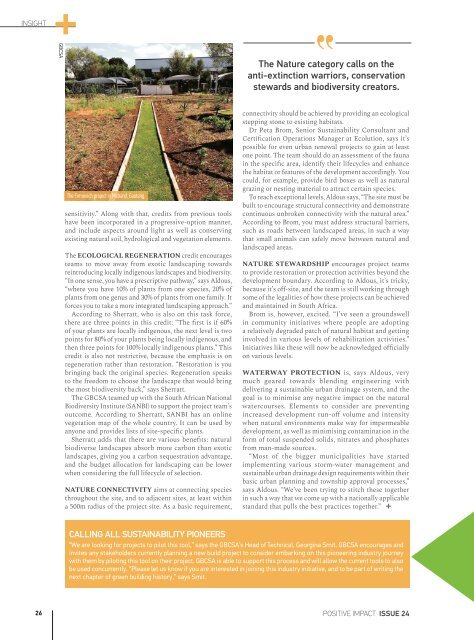+IMPACT MAGAZINE ISSUE 24
You also want an ePaper? Increase the reach of your titles
YUMPU automatically turns print PDFs into web optimized ePapers that Google loves.
INSIGHT<br />
Application-specific Release Oils<br />
GBCSA<br />
The Firmenich project in Midrand, Gauteng.<br />
sensitivity.” Along with that, credits from previous tools<br />
have been incorporated in a progressive-option manner,<br />
and include aspects around light as well as conserving<br />
existing natural soil, hydrological and vegetation elements.<br />
The ECOLOGICAL REGENERATION credit encourages<br />
teams to move away from exotic landscaping towards<br />
reintroducing locally indigenous landscapes and biodiversity.<br />
“In one sense, you have a prescriptive pathway,” says Aldous,<br />
“where you have 10% of plants from one species, 20% of<br />
plants from one genus and 30% of plants from one family. It<br />
forces you to take a more integrated landscaping approach.”<br />
According to Sherratt, who is also on this task force,<br />
there are three points in this credit: “The first is if 60%<br />
of your plants are locally indigenous, the next level is two<br />
points for 80% of your plants being locally indigenous, and<br />
then three points for 100% locally indigenous plants.” This<br />
credit is also not restrictive, because the emphasis is on<br />
regeneration rather than restoration. “Restoration is you<br />
bringing back the original species. Regeneration speaks<br />
to the freedom to choose the landscape that would bring<br />
the most biodiversity back,” says Sherratt.<br />
The GBCSA teamed up with the South African National<br />
Biodiversity Institute (SANBI) to support the project team’s<br />
outcome. According to Sherratt, SANBI has an online<br />
vegetation map of the whole country. It can be used by<br />
anyone and provides lists of site-specific plants.<br />
Sherratt adds that there are various benefits: natural<br />
biodiverse landscapes absorb more carbon than exotic<br />
landscapes, giving you a carbon sequestration advantage,<br />
and the budget allocation for landscaping can be lower<br />
when considering the full lifecycle of selection.<br />
NATURE CONNECTIVITY aims at connecting species<br />
throughout the site, and to adjacent sites, at least within<br />
a 500m radius of the project site. As a basic requirement,<br />
The Nature category calls on the<br />
anti-extinction warriors, conservation<br />
stewards and biodiversity creators.<br />
connectivity should be achieved by providing an ecological<br />
stepping stone to existing habitats.<br />
Dr Peta Brom, Senior Sustainability Consultant and<br />
Certification Operations Manager at Ecolution, says it’s<br />
possible for even urban renewal projects to gain at least<br />
one point. The team should do an assessment of the fauna<br />
in the specific area, identify their lifecycles and enhance<br />
the habitat or features of the development accordingly. You<br />
could, for example, provide bird boxes as well as natural<br />
grazing or nesting material to attract certain species.<br />
To reach exceptional levels, Aldous says, “The site must be<br />
built to encourage structural connectivity and demonstrate<br />
continuous unbroken connectivity with the natural area.”<br />
According to Brom, you must address structural barriers,<br />
such as roads between landscaped areas, in such a way<br />
that small animals can safely move between natural and<br />
landscaped areas.<br />
NATURE STEWARDSHIP encourages project teams<br />
to provide restoration or protection activities beyond the<br />
development boundary. According to Aldous, it’s tricky,<br />
because it’s off-site, and the team is still working through<br />
some of the legalities of how these projects can be achieved<br />
and maintained in South Africa.<br />
Brom is, however, excited. “I’ve seen a groundswell<br />
in community initiatives where people are adopting<br />
a relatively degraded patch of natural habitat and getting<br />
involved in various levels of rehabilitation activities.”<br />
Initiatives like these will now be acknowledged officially<br />
on various levels.<br />
WATERWAY PROTECTION is, says Aldous, very<br />
much geared towards blending engineering with<br />
delivering a sustainable urban drainage system, and the<br />
goal is to minimise any negative impact on the natural<br />
watercourses. Elements to consider are preventing<br />
increased development run-off volume and intensity<br />
when natural environments make way for impermeable<br />
development, as well as minimising contamination in the<br />
form of total suspended solids, nitrates and phosphates<br />
from man-made sources.<br />
“Most of the bigger municipalities have started<br />
implementing various storm-water management and<br />
sustainable urban drainage design requirements within their<br />
basic urban planning and township approval processes,”<br />
says Aldous. “We’ve been trying to stitch these together<br />
in such a way that we come up with a nationally applicable<br />
standard that pulls the best practices together.”<br />
• Tel: + 27 11 822 2320<br />
• Fax: + 27 11 822 2354<br />
• e-mail: cindy@ashak.co.za<br />
• Bonding Agents<br />
• Chemical Anchors<br />
• Concrete Bonding<br />
• Concrete Crack Repairs<br />
• Concrete Release Agents<br />
• Concrete Repair Mortars<br />
• Curing Compounds<br />
• Epoxy Adhesives<br />
• Epoxy Grout<br />
• Joint Sealants<br />
• Non Shrink Grouts<br />
• Pre Cast Repairs<br />
• Water Proofing<br />
6848 Ashak Constrctn 1/2pg ad JULY’23 IMPACT<br />
and other Quality Formulated<br />
Products to enhance<br />
Creativity<br />
in Concrete<br />
Construction!<br />
CALLING ALL SUSTAINABILITY PIONEERS<br />
“We are looking for projects to pilot this tool,” says the GBCSA’s Head of Technical, Georgina Smit. GBCSA encourages and<br />
invites any stakeholders currently planning a new build project to consider embarking on this pioneering industry journey<br />
with them by piloting this tool on their project. GBCSA is able to support this process and will allow the current tools to also<br />
be used concurrently. “Please let us know if you are interested in joining this industry initiative, and to be part of writing the<br />
next chapter of green building history,” says Smit.<br />
26 POSITIVE IMPACT <strong>ISSUE</strong> <strong>24</strong>

















